|
|
You are reading the older HTML site
Positive Feedback ISSUE 63
modwright instruments KWI200 Integrated Amplifier as reviewed by Steve Lefkowicz
It seems every review I write I have to start with explaining my focus on lower cost, or more affordable equipment. As long as I have been with PFO, even dating to when it was still the print publication audioMusings (or my time with Listener before that), I have had an agreement that I won't review products that sell for more than $3000. There have been a couple times I have gone slightly over that price point; once when I wrote a review of several sets of speakers that were "around the $3000 mark" and a couple were a few hundred dollars over. At the same time I also reviewed the 47 Labs Gaincard, that was quite a bit more than $3000, but part of that was that the Gaincard was made available to me, and I felt it would be a good extra amplifier option for the speaker review. Otherwise I have stuck to my self-appointed stance as the "budget audiophile" guy. I just think that there is a need for companies to make exceptionally good gear at not-outrageous prices, and for someone to seek them out and review them without condescension and derision. So, there I was with our Fearless Leader (Dave Clark) at a LAOCAS (Los Angeles Orange County Audio Society) meeting, mostly hanging out and chatting with friends. The system on display showcased speakers by Van L Speakerworks of Chicago (whom I had never heard of before) and the new integrated amp from ModWright Instruments, the KWI200. ModWright is a company and brand name that should be well known to PFO readers. Dave introduced me to Dan Wright, proprietor, designer, and the man in charge of ModWright, and we all chatted for bit. Dan Wright is much younger and mellower than many of the designers and builders I've met over the years. At least he looks younger, though he's been in business since the early 1990s. And though he comes across as mellow, there is a sense of intensity apparent in him when it comes to his designs and products that sets a very serious tone. A little later, Dave asks if I want to review the amplifier. "How much does it cost?" was my first question, as it usually is when offered gear. "About $6500" was the answer. "Probably not, then. It's too expensive." my answer, as usual, when offered expensive gear. Then Dave hit me with some brilliant, but basic logic. "Would you review a $3000 amplifier?" "Sure." "Would you review a $3000 preamp?" "Sure." I could see where he was going with this. "Would you review a $1000 DAC or phono stage?" "Sure" "Well, what's the difference with putting them all together?" It made sense to me. Looking at it that way, this actually comes well within my price range from a total system approach. Though, to my thinking, it is certainly easier to buy those items separately over time, rather than plunk down six large all at once. But then, remembering that the designer of my current favorite speakers, Eric Alexander of Tekton Design, stressed the idea that "you can never have too much power" in spite of making very high efficiency designs, got my juices flowing over the prospects of powering my 98dB efficient Tekton Lores with 200 watts of high end MOSFET power. Dan Wright let me take the amp right from the LAOCAS meeting, and home with me it went. Actually, it turns out this unit isn't quite $6500. That would be for the fully decked out version with both the built in DAC and the phono stage. This amp (Serial #102) was fitted out to bring to the meeting, and since there would be no turntable at the meeting, it came with no phono stage. This lowered the price to just $6150.
The KWI200 is a real Integrated Amp in that it has a real active linestage, a full power amplifier section, and, in this particular case, an integral 24/192 DAC, with both USB and SP/DIF (RCA) inputs. It is fairly large (17¾ wide x 17½ deep x 6½ tall) and weighs in at a hefty 62lbs. It is beautifully finished, and really looks the part of an expensive, true high-end product. I especially like the way the ModWright logo is cut into the ventilation openings on the top of the amp. That just looks cool, as does the gentle blue glow shining through the same logo that sits smack dab in the middle of the front panel. That logo is flanked on each side by large two-digit digital displays. The left display indicates the choice of input, and the right display shows volume. They are large enough to easily see from across the room. Just outboard of the two displays are the two large control knobs; the left knob for selecting inputs, and the right knob for adjusting volume. It's a simple, but highly effective layout, and very nice looking setup. I won't get too much into specifications or technical/design stuff here; you can check the ModWright web site for that kind of stuff. However, a few basic points that should be generally important. The KWI200 has four single ended inputs, one balanced (XLR) input, a Home Theater bypass input that can also be used as a preamp input, one set of preamp outputs, a 12 v trigger out, and a nice set of 5-way binding posts for one pair of speakers. This review unit also had the optional 24/192 Asynchronous DAC, and offered both USB and SP/DIF (RCA) inputs for that. This unit also came with the standard (included) remote. It is a small plastic little thingy that looks like it would come with a $49 DVD player. In spite of how it looks, it works well, and allows controlling volume, mute, input selection and dimming the display, which is pretty much all you need out of a remote. For those who want their remote to look as nice as their other audio gear, ModWright does offer an optional remote with a larger matching aluminum case, that for some people will be well worth the extra $200. I'll remain the "budget guy" in this instance, and be happy with the standard remote. I like that they offer the option. Setup for an integrated amp is, of course, very quick and easy. Except, with the amp weighing in at about 62lbs I didn't really want to put it on the 3/4-inch MDF shelves of my home built "flexi-rack." I instead used a Sound Organization floor stand (designed for the Linn turntable), replacing the thin MDF shelf with a leftover shelf from the flexi-rack, supported from underneath by four hockey pucks. This was stable and secure. I plugged my Marantz SA8001 SACD player, into one analog input, ran some cables from the record out of my PS Audio 4H preamp into another set to use the phono section from that unit (Nordost Solar Wind in both cases). I ran the USB cable from my IBM T42 notebook into the USB input (Straightwire USB Link), and used a Belkin PureAV digital cable to connect the Marantz's digital out to the SP/DIF input (for CD playback only). I plugged the Tekton Lores into the 5-way binding posts (using Nordost Solar Wind with bananas) and fired everything up.
One last bit of setup was to install the M2Tech USB to SP/DIF driver on my IBM T42 notebook server, which is needed for the installed asynchronous DAC. I then switched the Output Mode in J River Media Center to Kernel Streaming (more on J River Media Center is forthcoming in my series on low cost computer audio, but it is a wonderful product). I made no other changes to JRMC or to my server, and had no issues or complications with playback at all. If it weren't for the blue glow from the logo and the two digital displays, I would not have known the unit was on. I have never had a major piece of gear in my system that was so totally dead quiet. The isolated transformer of my PS Audio preamp hums a little. If I put my ear on the case of my B&K ST-140 I hear a little hmmmm in the background. When my Antique Sound Labs tube amp is on, there is a barely perceptible level of background noise coming through the speakers, even if I do have to be within an inch or two of a driver to hear it. Pretty much every amp or preamp I've ever had in for review gives some indication, even if barely perceptible, of its presence in the system(1). Not so with the KWI200. With the volume control up all the way, and my ear an inch from the tweeter, I heard nothing. I let everything warm up for an hour, and not only was the unit absolutely dead quiet; it was barely warm to the touch. I decided to give the system 24 hours of warm-up before committing to any evaluations. I have found that, generally speaking, a good warm-up is more important for solid-state gear than tube gear. Basically, I just set the server to shuffle and let it play. I did notice that over the next hour or two, the sound improved slightly, smoothing out, and especially in terms of bass response, becoming more powerful and precise. By the following day, everything appeared settled in and stable, and it was time to start listening for real! So, what to do next? Should I listen to LPs, CDs, SACDs or just let the server play? What would give me the best indication of what this amplifier, the most expensive product I've ever had in my system, was capable of? I decided to just stick with the server on shuffle for a while. I figured this would give me a good overall sense of the sound without looking for anything specific. Next thing I knew it was about four hours later, and I missed lunch. This was as much a session for pure enjoyment as for any "serious review evaluation" type of listening. Several things struck me as significant during this session. I was curious if these initial impressions would hold up over time (hint – they did). The characteristics that gripped me and held my attention were:
First, it didn't take long to hear what the benefits of lots of clean, pure power can do for your system. The Tekton Lores are very dynamic and powerful sounding speakers, and I had felt over the past year that even the fifteen watts my Antique Sound Labs provided was more than enough to play at any volume that I would care to listen. However, there is a difference between overall loudness and dynamic capability. Even when played at the same overall volume, the Modwright KWI200 was substantially more dynamic than the ASL. The difference in relative loudness between notes, the separation of subtle levels at either the softest or loudest portions, or the suddenness of any change in volume, was unlike anything I have heard before. It wasn't the change in volume, but the quickness and precision of those changes that was so exciting. By comparison, my little tube amp sounded slow and tentative. Something I had never felt about that amp before. When big notes, especially big bass notes, were played, they jumped out with such a sense of immediacy and effortless power. It was the type of "effortlessness" that you expect from the big-ticket items, and generally, for me, marks the difference between merely good hi-fi and the real high-end. It is not something I expect to hear from a system using a $1000 set of speakers. The noise floor being so extremely low (non existent for all practical purposes) I felt this had a direct correlation to the overall sense of transparency and level of detail bestowed on the system. There was so much real information to hear, about the recordings being played and the music contained therein, that I found myself on a serious quest to reduce the ambient noise level in my listening room. Of course we all strive for a proper quiet listening environment, but something about having the KWI200 playing made this seem ever the more important. Closing all the windows in the house, not just the listening room, pulling all drapes and curtains shut, turning off all lights in other rooms (we use modern fluorescent bulbs throughout the house), and not just making sure all the TVs were off, but unplugged. I was tempted to unplug the refrigerator, but decided against that. The point here, being that more than I have ever noticed before, any and every effort to reduce any ambient noise resulted in hearing more of the ModWright had to offer, and way beyond anything I've experienced with any other electronics I've had in my system over the past many years. I know it sounds cliché to say you hear things you've never noticed in familiar recordings, but that was actually the case here. Little percussive details buried in a mix, subtle cues about the recording environment, hearing each individual instrument in an otherwise complex or dense mix, all become easily heard. With the KWI200 handling amplification (and in this case DAC) duties, all it takes is a source that doesn't obscure the details, speakers that can reproduce them, and a room quiet enough to not mask them in ambient noise. When I refer to "control" what I mean is how the KWI200 has the power, speed, and authority to take charge of the speakers and make them do its bidding. The combination of power, speed, and neutrality allows the amp to quite literally force the speakers to accurately play the signal it's sending them. The extent to which notes, especially bass notes, were fleshed out was uncanny. Hearing how well it handled the high efficiency and easy load of the Tekton Lores, I thought I should give my other high value reference speakers, the Direct Acoustics Silent Speakers a chance. In John Marks' excellent Stereophile review of the Silent Speaker 2 a couple years ago (an updated version of the Silent Speakers that I have) he stressed how the speakers really needed higher quality amplification than most people would probably use with them. I initially thought it was another absurd case of saying you need thousands of dollars of electronics to make a $700 speaker sound good. It wasn't, and Mr. Marks was pretty much right. Running this $6000 amplifier into my Silent Speakers, really showed two things; it showed just how good a design the Silent Speaker really is, and it showed just how important a good amp like the KWI200 can be. One of my prior complaints about the Silent Speaker was that, though the bass was extremely deep and powerful for a small two-way speaker, it wasn't the most precise or detailed bass. The Tekton Lore, though not quite as powerful below 50 Hz, was much more natural sounding. Here, driving the Silent Speakers with the KWI200, I now had stunning, powerful, deep and tuneful bass. Pretty much every aspect of the sound from the Silent Speaker was improved, (see issue 26 for the review) that is, the positive aspects of the speakers were even more positive, and the negative aspects were all lessened. I am still uncomfortable with the idea that low cost speakers need expensive amplifiers to sound their best, but I am encouraged by the prospects for long term ownership that these two affordable speakers systems sound really good with moderately priced electronics, while sounding even better as you step up to higher quality amplifiers.
Now, looking at some other aspects of the KWI200, we have to consider the built in optional DAC. There a lot of options on the market for DACs in the approximate $1100 price range for the ModWright DAC. I did not have any of them for direct comparison, but had four lower cost DACs (ranging from $199 to $399) in house. I'll be discussing those four in the next installment of my Low Cost PC Audio series. However, simply put and without any question, the built in DAC was clearly superior to all four of the budget DACs. Running my IBM T42 notebook server (Win XP, J River Media Center) through any of the four budget DACs, the differences were all in terms of how close could they might come to the sound of my Marantz SA8001 player when playing files (Apple Lossless or FLAC) ripped from the CD. Some came pretty close, some closer than others. A few were good enough that I could be happy listening to them instead of dealing with CDs and the dedicated player. Streaming the server through the USB input of the ModWright was a different story. Comparing FLAC or Apple Lossless files from the server with the CD played on the SA8001, I actually preferred the sound from the server. There was a clear improvement in dynamics, detail, transparency and even in tonal balance. The Marantz sounded a little tipped up in high frequencies compared to the server. After just a few days of comparing, I found myself only using the Marantz player to listen to SACD disks.
What was more interesting was comparing the Marantz player's digital output fed into the SP/DIF input of the ModWright to the player's analog output and to the same tracks played from the server. I still preferred the sound from the server to either outputs of the Marantz player, though I preferred the digital output of the Marantz to the analog output. Unfortunately, I only had an inexpensive Belkin PureAV digital cable (about $6 through Amazon.com) to feed the digital output to the ModWright DAC. Maybe a better cable would have changed that opinion.
Of course when I played high resolution files from the server things were even better. I don't have a lot of hi-res files yet, just 24/96 FLAC files from the recent King Crimson and Doors reissues, 24/94 WAV files from John Mellencamp, some wonderful samples from MA Recordings (both 24/96 and 24/88) and a 24/96 file of Stravisnky's Right of Spring (Stravinsky conducting the Columbia Symphony) that fellow PFO reviewer Andre Marc made for me from an early LP to compare to my LP and SACD releases of the same recording. With J River Media Center automatically handling the various sample rates and sending a bit perfect digital stream to the DAC, this was the promise of digital audio realized.
And so it went, for the next several weeks. I kept trying to find something to criticize. Something that I've heard done better that I could attribute to the ModWright, rather than my sources or speakers. Maybe, I've heard a slightly more organic, believable sense of image from a tubed preamp or linestage (thinking of my time with the Audio Space Line-2). Maybe that's why ModWright's more expensive separate preamps are all tubed units. This integrated amp is his entry level after all. Oh, and I wish the KWI200 had a real headphone output as an option, too. I would have loved to have been able to plug my headphones in to this and been able to use the remote for adjusting volume.
So, where do I stand with the idea of having a $6000 amplifier in my system? Well, from one standpoint, I love it. The KWI200 mates up extremely well with both of my favorite speakers, and the combination offers up a quality of sound that is likely hard to beat in a system using sub-$1000 speakers otherwise. I have generally been a believer in the old Linn "source first" philosophy, basically always looking to feed the signal from one piece into a piece that is of equal or slightly less overall quality. The idea being feeding a signal into a "better" piece will just better show the flaws or inadequacies upstream. I've found it hard to always put a dollar figure in that hierarchy. The KWI200 is clearly "better" than either of speakers, and so it seems allows them to play at their best. Maybe my opinion would be different if I was playing into some $15,000 speakers. It's highly unlikely I will ever be doing that. But in terms of system building, an integrated amp like the KWI200 makes a lot of sense. If it had the phono section, I would only really have needed a couple of cables. With the cost of decent cables these days that could amount to hundreds even thousands of dollars in savings. For quite some time, I have kept a little spreadsheet with recommendations for a "$10,000 system" that I felt would give real high-end sound without getting into the silly extravagant price range. That's pretty close to what I'm looking at right now. Here is a possible $10,000 system using the KWI200:
Notebook generic, Win 7 ($500) Total cost $9880 I think a system like this could give serious, long-term satisfaction and bring a lot of musical happiness to someone's home. Like a lot of audiophiles, I've often thought of my "retirement" system as being centered around the ease and simplicity of a good integrated amp. In spite of many years of thinking of myself as a low powered tube amp kind of guy, I have to say, I could very happily and enthusiastically retire with the KWI200 as the centerpiece of my system. It is a joy to listen to, to use, and even just to look at. Very highly recommended. Steve Lefkowicz
KWI200 Integrated Amplifier
ModWright
(1) The one exception being the Audio Space Line 2 linestage. (2) Please note the Black Cat Firefly is not available yet, but based on hearing their slightly more expensive cables a few times, and their history of good design, I think it has a chance of being a good option. Feel free to substitute your favorite low cost cable.
|








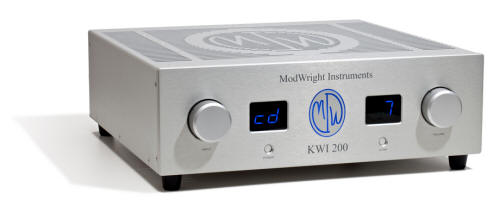
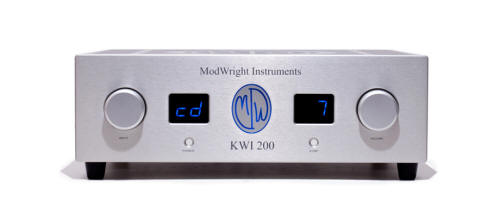
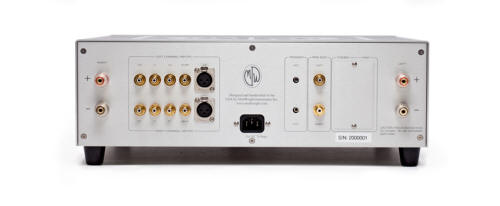
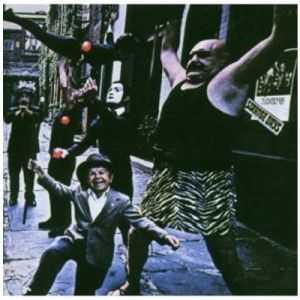
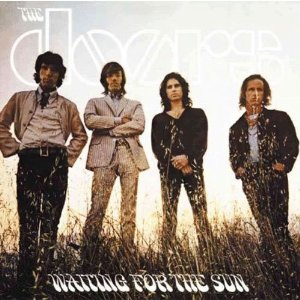
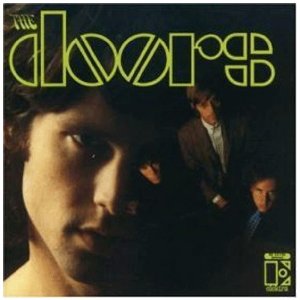
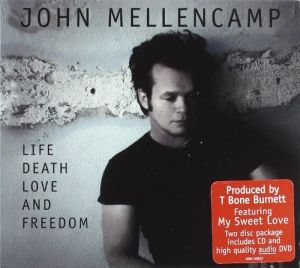
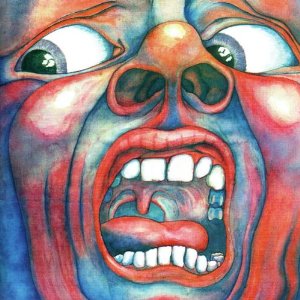
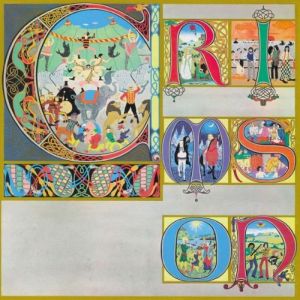 >
> >
>